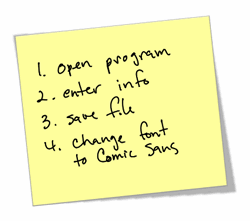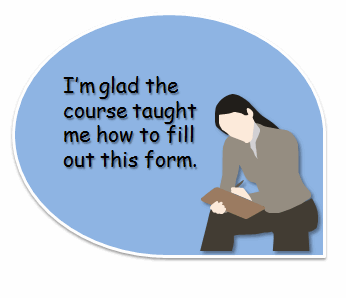Excellent post, Tom! I have often thought that, by the time we’ve finished putting together our bells-and-whistles solution, it’s obsolete, because the users have figured things out for themselves. Perhaps, when it comes to software rollouts, “courses” are not the way forward at all. The user in those situations usually just wants ad hoc performance support on a JIT basis. We can save the bells and whistles for another time.
What We Can Learn About Instructional Design from Post-it™ Notes
February 19th, 2008
If you’re like me, your computer monitor and workspace is plastered with Post-it™ notes, quick reference cards, and other job aids filled with tips and reminders.
Last week, I posted on doing a simple needs analysis, Cathy Moore made an excellent point that looking at your learner’s Post-it™ notes and other self-made reference aids can help you decide what information should be included in a course.
Why do people use Post-it™ notes, cheat sheets, and other job-aids to help them do their jobs? And, how does this relate to elearning?
Why Do We Create Cheat Sheets?
I think the widespread use of Post-it™ notes and cheat sheets reveals a lot about the way people learn and how they apply that knowledge to their jobs.
A few years ago, I worked on an IT elearning project that took months to build. By the time we were ready to roll it out, we found that some of the machine operators had already created a bunch of "cheat sheets" and passed them out to everybody on the floor.
Sure enough, instead of our course’s "certificate of completion" beautifully framed and displayed at their workspaces, all of these people had crude looking cheat sheets taped to their monitors. It really was quite shocking.
Who do these people think they are? None of these sheet cheaters knew a thing about adult learning principles and diverse learning styles. I’m sure that they’d never heard of ADDIE or Bloom. And to make matters worse, they used the nemesis font of all instructional designers, Comic Sans MS!
Yet, despite their obvious ignorance of things related to sound instructional design, they accomplished in a couple of hours what our team had spent months doing, albeit with much less detail. And that, I believe, is the crux of our problem. As instructional designers, sometimes it’s hard to step away from the detail.
Cheat sheets are a way for people to hone in on the key points that are relevant to what they do. By creating cheat sheets, the learners are filtering a lot of the detail and bringing to focus what they find to be the most important information. Plus, if they ever really do need more detail, they can always blow the dust off of one of their training manuals, look online, or call the training group.
How Do Cheat Sheets Relate to E-Learning?
If we wanted to, we could start all of our elearning at Genesis 1:1 and then move on from there. However, we recognize that that level of detail is more than necessary. So we decide to reel it in and instead start at the history of whatever it is we are teaching. Let me give you an example how this might look.

I’ve done a lot of elearning courses for financial institutions. As you can imagine, they are heavily regulated and require a lot of training. The employee needs to learn how to fill out a document. If she asked her co-worker for help she’d get a quick walk-through of the process. She’d make some notes and then paste them on her monitor. This could be done in a few minutes.
On the other hand, an elearning course will start by teaching her the history of the lending profession and how the nation of Yap used stone money. However, since we use paper and not stone, we need various regulations to manage our industry. Then she gets to learn about every detail of the regulations: what instigated them, what year they were created, and how her organization is responding to the regulations.
Somewhere near the end of this process, she’ll eventually see the form she needs to complete as part of her job. The entire course will take 60 minutes to teach what her co-worker could have taught her in about five. To make matters worse, she’ll be forced to play a Jeopardy-style game to reinforce her ability to answers questions about this or that lending regulation and yet never be assessed on her ability to actually complete the form.
While some of this is slightly exaggerated, the main point is that a lot of elearning tends to have more information than is necessary to learn the task. As Cathy suggests in her comment, there’s something to be learned by reviewing the notes that the learners create for themselves. And it is this information we can apply to how we design our courses.
Do You Want to Win at Trivial Pursuit or Do Your Job Well?
The ultimate goal of elearning is to change behaviors. So, to be successful, focus on the behaviors you need to change. Consider my example above. I’m not saying that the regulations and contextual information isn’t important. Instead, what I’m suggesting is that perhaps it isn’t important to be covered in the elearning course itself.

Learners filter out a lot of the detail because it’s not critical to them getting the job done. Take a close look at what the learner is writing on her notes. Is she listing all of the "What do I need to know" information? Or, is it more like, "What do I need to do?" My guess is that the learner is making notes based on what has to be done rather than what needs to be known.
In the same respect, you need to do this when designing your elearning courses. As you go through the reams of paper and subject matter expertise, you’re job is to:
- Determine the objectives
- Select the information that will help meet them
- Organize it in a manner that makes sense to the learner
- Create a learning experience for the learner to practice using it
- Provide feedback to the learner
Where does the contextual detail fit into that list? An old mentor of mine used to say, "Imagine you only get one piece of paper for your course content. Carefully decide what makes it on that page and still lets you meet your goals."
This wasn’t a steadfast rule, but as an exercise, it forced us to carefully go through the information and think about how to present it in our elearning courses. We learned to weed out the excess.
The good thing with rapid elearning tools is that you can have the best of both worlds. You can create elearning courses that are concise, media rich, and to the point while still adding links or attachments to more detailed information. And, if you create job aids or "cheat sheets" for your courses, you can include those as well.
What do you do to create practical, relevant courses and avoid making them just information dumps? Feel free to share in the comments section.
Events
- Everyday. Check out the weekly training webinars to learn more about Rise, Storyline, and instructional design.
Free E-Learning Resources
 |
 |
 |
|
Want to learn more? Check out these articles and free resources in the community. |
Here’s a great job board for e-learning, instructional design, and training jobs |
Participate in the weekly e-learning challenges to sharpen your skills |
 |
 |
 |
|
Get your free PowerPoint templates and free graphics & stock images. |
Lots of cool e-learning examples to check out and find inspiration. |
Getting Started? This e-learning 101 series and the free e-books will help. |
38 responses to “What We Can Learn About Instructional Design from Post-it™ Notes”
Hi Tom
Interesting post.
Cheat Sheets are often used in Software Products.
I have created a couple of Cheat Sheets and find them extremely useful.
I have written a post about Cheat Sheets in Eclipse here : http://writersgateway.wordpress.com/2007/04/12/interactive-help-manuals-cheat-sheets-in-eclipse/
Hope you find it useful.
Lots of great points, Tom. Some clarification of my comment on the previous post: For any procedure that’s more than a few easily memorized steps, I like to put the procedure in a job aid and use a (short!) course to show the learner how to use the job aid.
So maybe the financial forms course basically says, “There’s a form you need to fill out regularly. Here’s what it looks like. Here’s a link to a document/site/whatever that has the detailed steps for completing the form. You’ll use that aid on the job. Open that aid now and follow along while Fictional Ann completes the form for Fictional Client. Got it? Okay, now you have a Fictional Client of your own. Use the aid to complete this on-screen simulation of the form. You’ll get feedback at each step.”
The problem I run into a lot with any extent of peer-weighted training (for almost every task) is the Multiplicity Effect. At some point one person has skipped a step or puts the wrong emphasis on one concept while glossing over another. So a few months later half of the team is doing something completely different than what is needed.
And yeah, this is an issue with something as simple as filling out a form.
It’s a difficult paradigm to manage when you have high turnover but a small to medium sized workforce. If anyone creates a magic bullet for this issue, I’m all ears.
OK…here’s a question for you all: what are the chances that the sticky note cheat sheets written by the students are guaranteed to be more effective than anything we can write for them? If we write the cheat sheet, they may not pay attention as closely because they’ve already got their lifeline. Anything the students write themselves will not only be the most meaningful, but it will also be written in a way that the student best understands.
So, perhaps the writing of cheat sheets should be added as a training exercise, either for each unit, or at the end of the course. In a perfect world (one with enough resources), the cheat sheet information from each student could be checked for accuracy, and produced into a nice-looking sticky note for the student to proudly display back on the job.
Just a thought.
Thanks Tom for posting this wonderful reminder.
Ironically, the other day, another ID that I’ve worked with in the past, was asking me about an upcoming project. My client has asked for a step by step manual of sorts to be developed into an online learning experience. Considering that neither of the manual developers have an ID background, the manual is quite good.
This project is refreshing. There’s already good content mapped out, along with screen shots, etc. which makes my job oh so much easier when starting to make the transition from a hard copy manual to an engaging online learning experience. Much of my meeting with the SMEs is to determine what, if any, content tends to change. For example, when a newer version is available, does that change any part of a process? Does it change the steps in the process, either creating additional steps or reducing them?
The manual is based on an in-house created template that all of project estimators use. I don’t feel compelled to explain the history of this template. And the learners don’t want to hear it either.
What the learners are telling me is that they just need to know “how” to use it. So, while I will include scenarios or “what ifs” in the module, I’m not going to include extra content, such as historical background, games that aren’t applicable, etc. that ultimately wastes learners’ time.
But this very concept is what is so difficult for my colleague to grasp. “How can we begin to develop the online experience, if we don’t have all of the content for this module? What is the ‘why’ behind all of it? It can’t just be a tutorial.” I argue that we have the content that the learners need and can immediately apply — which allows them to effectively perform their job.
Isn’t that what we are trying to accomplish as IDs? Helping people learn so that they can apply the skills?
This whole shift takes me back to Junior High, when I remember struggling with a process in Science class. I asked my older brother one evening, “it’s not a matter of how this works. I just want to know why?”
He responded, “just know that it does. That’s all that matters. You’ll drive yourself crazy if you keep asking ‘why’ about everything and in the end, you won’t understand the process any better. Just know that, that is how it is.”
I realize that this was a pretty vague discussion, but perhaps it was my first glimpse of becoming an ID thrown into the ways of needing to explain everything. Ask Tom noted, getting caught up in the “details,” of which I’m teaching myself to let go of. 🙂
Our company has exhaustive documentation of policy and procedure. Our new hires find the amount of detail, background information and exceptions to each rule overwhelming and dificult to understand.
A large chunck of our new hire training is devoted to learning how to read all that process documentation. I’ve found the most impactful learning activity is to have the class create their own cheat sheets for each procedure. Some like words, so they create an outline, others prefer flow charts and visuals. The class shares their ‘shortcuts’ and we critique them as a class. Not only does this ensure we don’t miss anything critical, many “ah – ha’s” are heard from other participants that “hadn’t thought of it that way before”.The best part of having the learners create their own cheat sheets, is that our business changes constantly. We as trainers don’t need to constantly update materials!
Tom,
Excellent post! I totally agree with the cheat sheet/post-it note process. I’ve also found this to be very effective when conducting a job task analysis.
Consequently, when I meet with SME(s) to learn the details of a job, I search the surrondings of his/her area for notes. I create my own cheat sheet based on what I see and I’m told. After the first meeting, I look over my sheet, create a typed document and review steps with the SME(s)-in the second meeting. In this way, I can fill in any steps that I may have missed.
That’s my two cents worth!
That’s an interesting persprective, Tom.
To add to the line of thought, consider WHY ad-hoc job-aids (“cheat sheets” sort of has a negative connotation to it, don’t you think?) and training happens. In my experience, it’s because there was a need that was unfulfilled by a training intervention — whether the training just took too long to be developed, or the training was poorly designed (as in off-target like the history of the banking industry).
I’ve found that while these are useful pieces of information, they often focus on only a small part of a larger process. And that’s not bad in itself — but it can have unexpected consequences, such as lack of standardization.
Consider, for example, filling out a form. If there are several branch offices, and each develops it’s own job-aid to do that, it’s likely that when the forms are forwarded to the main office for the data to be collated, we’d see that the forms are filled out differently from each branch.
So I guess my two cents say that as instructional designers, take those independently produced job-aids with a grain of salt until you can compare them with a solid task analysis.
THanks again, Tom, for putting this blog together!
All,
What I would like to add is, there is a lot of follow-up to my cheat sheet process. I never go with the first responses. The steps are practiced and reviewed among many.
Thanks!
I love the idea of learners creating their own job aids and then sharing them with each other. Maybe this could be done in an asynchronous course by using a wiki. Hand-drawn cheat sheets could be scanned & posted; others would probably just be typed in.
The first several learners to go through the course could be required to post their job aids in the wiki. Later learners could be required to vote for their favorite job aid and suggest improvements to it, or submit their own. One or two SMEs assigned to be editors could keep an eye on the cheat sheets and correct any inaccuracies. After awhile, the 2-3 most useful cheat sheets would rise to the top.
This is probably too “out there” for many companies because it has the messiness typical of 2.0 approaches, but it could be one way to get asynchronous learners to interact with others’ ideas.
Following on Cathy’s last post and Tom’s response, it might be good then to have the IDs gather all the informal and wiki based cheat sheets and combine them into officially sanctioned cheatsheets published on paper as part of the training intervention, through elearning, or online by “cleaning up” the wiki or using a software tool such as Smart@s that can create context sensitive “cheat sheets”.Smart@s is specifically designed to provide guides for online systems that can popup to provide the same function as Post-It Notes in Tom’s article. these guides could be enabled to be “pulled up” when needed based on the current users context.We use Smart@s in this fashion. See link for more info.
[…] Design from Post-It Notes – An Interesting Read Tom Kuhlmann has again come up with an interesting post. This time it is on Cheat […]
Intresting comments. I am an experienced instructional designer, but I’m also a one/two-man-band in a lot of ways – there’s just me and 1 training officer, and we design, develop, and deliver almost all of our training, both soft and hard skills.
Particularly for hard skills, like form filling or software functions or how to apply procedures, I often start my design process by documenting a brief cheatsheet of the steps involved in the process that needs to be learned. That is refined and developed and put into a concise but clear format with screenshots where approriate, and is given to learners with their other course materials. Learners’ responses to resources are so varied depending on personality type and temperament and learning style. There are the few, like me and Marnie’s colleague, who have a desperate need to know why – they’ll be NT Rational/Theorist temperaments (see http://www.temperamentzone.com and other Myers Briggs related sites for more info). But for the main part, most people just want to know how to do the thing they have to do.
So we shouldn’t fight this – we should embrace it! Provide it in the first place! We write very “full” manuals and workbooks and other sorts of reference tools, but the majority of people are not going to bother looking at them later. But almost everyone will look at a well-designed and put-together cheatsheet. We give them a good one, and recommend they pin it to their office/cubicle pin-board while they practice the new skill.
For simple topics, sometimes I find that a course is not even required. I am working on one today that is shaping up that way. And it’s great to find out at this early stage rather than spend all that time and money developing a course that really isn’t needed and is just going to irritate people who have to do it.
I had not considered Emily’s brilliant idea of getting them to put cheatsheets together themselves during a class. I love this – provided it is vetted, as is suggested. But what a great collaborative resource with great learner buy-in! That’s going to produce high learner motivation, which in turn will help ensure that true learning actually takes place.
It’s really a great post. I used to teach instructional design in industry, to tell the intructors how to design an eLearning course. ADDIE is always the process I teach. As you say, how to solve the real task is hard to be seen in the course. Post-it notes is really a good idea. Thanks for the idea that I have more thinking about how to make an eLearning course.
Great Article!!
My unit is currently looking at the exact issue at the moment for our organisation. We are currently in the process of doing our market research on an effective tool that will help out with elearning and documentation. One component of that documentation is about the tool being able to produce job aids (cheat sheets).
Part of the lessons we have learnt is there needs to be a balance in the information that we provide. We have identifed that as we are a very strong policy driven organisation we still need the manual style of information initially however we also need to provide a job aid that will assist in the “things that they need to do”. One of these is to produce a cheat sheet style job aid.
A big concern within our oraganisation is about transperency and accountability. Our current thinking is if these job aids were vetted by the “Subject Matter Experts” then there would be more control over the accuracy of the information in the cheat sheet because lets face it not all information in an individuals notes can be garanteed to be correct. Remember the chinese whispers game!!
I know that there is a strong focus on adult learning principles and which have been touched on in your article however lets face it society is rapidly moving on and the current generation (Gen Ys) do think process and do things differently.
Thanks
Hi Tom,
Attimes a visual indication of the procedure or step is needed. Say you are explaining maintenance of a motor. You need to show what part is removed, and how. You can have an interactivity where you ask the learner to try-out something.
Can we put such information in a job-aid? Won’t the learner miss out on the crucial “show” factor for procedure-intensive, near-transfer courses.
-Anitha
[…] inspired by learners’ Post-it® notes: Tom Kuhlmann points out that the job aids learners create for themselves can help you focus your elearning materials. A […]
Great post, and maybe us instructional designers need to “get over ourselves” on always using the “instructionally sound” way that we have always done things and simply look around at what actually people use over and over again to get their job done…what a concept. Any good examples of job aids we can look at???
Tom,
What a very enlightening and inspiring post!
I absolutely believe that learners take note of what they think they are expected to do in a particular situation that is related to the topic being discussed by the teacher. I have long been a school administrator in public elementary schools in the Philippines, an education supervisor, a school superintendent. And I have observed that the learners inability to learn functionally is due to the teacher’s failure to let the learners demonstrate the tasks he is expected to perform. Assignments and homeworks are given but unfortunately, somebody at home — the mother, sister, or a tutor — does it for the child. Consequently, the purpose of any assignment or homework is defeated. Many teachers hold the belief that they once they have reached the end of the lesson or the last page of a chapter, then they have taught already. They don’t even care to check the learners’ ability and capability to perform tasks, even lifelong learning tasks.
In the context of elearning, it is really very important to plan very well the activities that go along with any learning material for a given lesson or topic. Whether the purpose of the elearning material is simply to give information or to change the learners’ behavior, the accompanying activities should be able to provide an effective opportunity for the learners to undergo a process that will firm up their learning or raise them to a higher level of thinking. In this way, learning takes place in the three domains: cognitive, affective, and psychomotor.
Thank you so much, Tom. i have found all your materials extremely useful and effective. All the best!
[…] read a very interesting post on one of my favorite e-learning blogs: “What We Can Learn About Instructional Design From Post-It™ Notes” (The Rapid E-Learning […]
Your blog was sent to me by a fellow instructional designer (Kathie Howard).
How can I receive your blog?
Thank you,
Kellye Cattenhead
Instructional Designer/Education Consultant
Children’s Memorial Hosptial
[…] is from an intriguing post by Tom Kuhlman on the Rapid E-Learning Blog: What We Can Learn About Instructional Design from Post-it™ Notes. I have to admit that I recognized myself in the description of a typical e-learning designer, who […]
[…] What We Can Learn About Instructional Design from Post-it™ Notes – The Rapid eLearning Blog Tom Kuhlmann runs the Rapid eLearning Blog, and here has a very interesting post on how sometimes we, as instructional designers, sometimes don’t get to what’s really important in our instruction. Great read, and a great blog! […]
An instructional designer sees Post-it notes as clues about what the user needs to learn. The solution is to focus training on these items. (Animated raccoon shows user that employee’s time off should be entered under “Employee Benefits>Details>Record Keeping…”, then the user is given a test to prove that they remembered that fact, at least for a few minutes.)
A tech writer sees Post-it notes as clues about where the existing product, manuals, help, and training are not providing needed information when and where it is needed. Either 1) the information is not being provided, or 2) the information is not conducive to being remembered and it is not easily accessible when needed. The solution is to simplify the information and bring it closer to the point of need. For example, information which is so important and frequently needed as to merit a post-it might be integrated right into the product interface. (Main screen of program has bold box which says, “To enter your time off, select Employee Benefits>Details>Record Keeping…”.)
A usability professional sees Post-it notes as clues about where the usability of the product falls short. The solution is to redesign the product so that the user does not need the information to operate the product. (Main screen of program has button labelled “Enter your time off”.)
An executive sees a messy (and therefore surely disorganized and ineffective) employee.
[…] What We Can Learn About Instructional Design from Post-it™ Notes […]
[…] for information and hunt for videos in YouTube. They prefer online tutorials, wikis, blogs and cheat sheets. They do not mind making mistakes and this is the way they […]
Your post echoes some thoughts I had on a new ‘genre’ of Instructional Design (minimalist learning – kinda inspired by Taoist principles), which I put down in the following blog posts many moons ago. You might find it interesting…
http://duskanddawn.blogspot.com/2003/11/minimalist-training.html
http://duskanddawn.blogspot.com/2003/11/knowledge-in-world-and-in-head.html
http://duskanddawn.blogspot.com/2003/11/minimalist-training-part-2.html
For the record, I’m with you all the way :0)
Mindful
I appreciate this blog post. I work at a community college in disability services and every piece of information we give students about our department and their responsibilities is something that could be written on a post-it note. We call this “memory aids”. Memory aids assist students with learning disabilities and executive functioning disorders in so many ways. This assists with their working memory and help them remember more than 7 things at once. When a student first comes in we give them multiple “post-it notes” to hang on to. The in the course of them working with their Academic Coach they learn to keep their own post-it notes. I’ve trained students to carry around a little spiral notebook and write down their little notes to be able to refer to. This works great for the student that can’t remember what was said at the Finanical Aid office. You post-it note theory could work for this catagory of student. You say “Create elearning courses that are concise, media rich, and to the point while still adding links or attachments to more detailed information”. Online courses are difficult for someone with executive funcitoning disorders, often online course are unorganized and send the student on a wild goose chase for course information and directions.
[…] design for e-learning. The blog has a ton of useful information, such as what we can learn from Post-It™ Notes. Everyone has had the experience of unbearably long training sessions that present reams of complex […]
The sticky note analogy was a good way to visually extrapolate all of the excess information that gets in the way of learning.
This analogy reminds me of my staff and I created tip sheets in the new non-linear editing labs of our Community Media facility. I identified a distinct need to make simple step 1, step 2, step 3 “cheat sheets” to help novice users of the very complicated equipment to gain some skill by focusing on the basics. As simple as A,B,C. It worked.
And, when any user had complications just about anyone could mentor them if they didn’t have the attention span to focus on the easy outlined steps by carefully reviewing the tip sheet to see what step they didn’t understand. Thanks so much for this visual learning aid.
This analogy also made me think of the keyboard shortcuts on a computer. The first thing I was shown 25 years ago was the CTL C, X, & V commands. Since I’m somewhat of an “analogue dog” (and it’s hard to teach an old dog new tricks) I was determined to learn all my digital editing on Macintosh computers using only hot keys (keyboard short cuts). It reminded me of editing in the old days by hitting buttons for in and out points, instead of having to navigate drop down menus and find individual commands or effects.
And, I still think those sticky notes helped me find my way when I was in overwhelm with information, by being able to pull up priorities and never having the fear of losing a thought as long as the sticky note was in tact. I.D. just cuts out all the distractions, like the video on your other blog of the moonwalking bear. Thanks so much for all the great ideas in your blog Tom, and the opportunities for discussion.
Going for exemplary grade here…pardon the repost. Take Two.
The sticky note analogy was a good way to visually extrapolate all of the excess information that gets in the way of learning. A study by Edie Williams takes this further in exploring how heavy electronic media use may cause distractions that can reduce the ability to think critically and disrupt analytical thinking needed in problem solving. (Williams, 2012) Ads on the Internet, pop-ups and email notifications are ways of stimulating attention and according to William’s, the brain has an insatiable need for stimulation. From what I have learned about how the brain processes information, this is an example of why it is good to break the information into manageable bits using our working memory long enough that we may relate the information to something we already know and potentially store it in our long-term memory.
Tom, your analogy reminds me of when my staff and I created tip sheets in the new non-linear editing labs of our Community Media facility. I identified a distinct need to make simple step 1, step 2, step 3 “cheat sheets” to help novice users of the very complicated equipment to gain some skill by focusing on the basics. As simple as A,B,C. It worked. And, when any user had complications just about anyone could mentor them if they didn’t have the attention span to focus on the easy outlined steps by carefully reviewing the tip sheet to see what step they didn’t understand. Thanks so much for this visual learning aid.
Your analogy also made me think of the shortcuts on a computer keyboard. One of the first things I remember being shown 25 years ago was the CTL C, X, & V commands. Since I’m somewhat of an “analogue dog” (and it’s hard to teach an old dog new tricks) I was determined to learn how to do all my digital editing on Macintosh computers using only hot keys (keyboard short cuts). It is reminiscent of editing in the old days by hitting buttons for in and out points, instead of the nonlinear fashion of navigating drop down menus and having to locate individual commands or effects.
And, I still think those sticky notes helped me find my way when I was in overwhelm with information, by being able to pull up priorities with no fear of losing a thought as long as the sticky note was in tact. Instructional Designers work to overcome the distractions, like your example with the video of the moonwalking bear. (Kuhlmann, 2008) It is our responsibility to focus the learner on what is important to get the job done.
Thanks so much for all the great ideas in your blog Tom, the opportunities for discussion and for rapid elearning!
References
Williams, Edie (2012). Driven to Distraction: How electronic media are affecting the brain and the implications for human resource development in the future. Advances in developing human resources. 14:626.
Kuhlmann, Tom. (July 22, 2008) What everybody ought to know about instructional design. The Rapid eLearning Blog. Retrieved from http://www.articulate.com/rapid-elearning/what-everybody-ought-to-know-about-instructional-design/
Hi Tom,
I must admit to being a user of Post-It notes myself, so your title caught my eye immediately. As a fledgling instructional designer, I’m intrigued by your mentor’s advice to put everything you need to teach on a single sheet of paper. Certainly that prioritizes information quickly.
Your fourth point, “Create a learning experience for the learner to practice using it” brought back my own memories as a learner. I’ve sat through so many training sessions where information was presented and then we were dismissed. Practicing using the new information toward the designated goal, with or without a “cheat sheet” needs to be addressed. The instructional designer is ultimately hoping to achieve a goal. If the learner doesn’t master the information in such a way as to be able to “use” it, then the goal will not be met. Often I’ve attempted to create “cheat sheets” as I sat in training sessions that included no time to practice the new information or skill in the hopes that when I was on my own later that I would be able to indeed truly use what had been presented to me. Feedback and practice are two areas that are often forgotten amongst the “bells and whistles” of the design world, yet I believe they are two of the most important for a designer to consider.
However, as Paul reiterates in her article “The Myth of Practice Makes Perfect,” there is more to the notion of simple practice (2012). I’ve also sat in training sessions and been told to implement some type of information or another, and I’ll admit, often I did not take the “practice” to heart; I simply looked busy. Paul quotes discusses Anders Ericsson’s 1993 paper that makes that point that practice by the learner needs to be “deliberate.” In order for practice to be effective, the learner must be invested in overcoming weaknesses and improving. I think that this goes back to your first point, “Determining the Objectives.” The learner needs to believe that the objectives of the instruction are valuable. This concept speaks to that emotional aspect of the learning process.
Thank you for your down-to-earth posts. I find them very informative and helpful.
References
Paul, A.M. (2012). The Myth of Practice Makes Perfect. Time. Retrieved from http://ideas.time.com/2012/01/25/the-myth-of-practice-makes-perfect/








0
comments